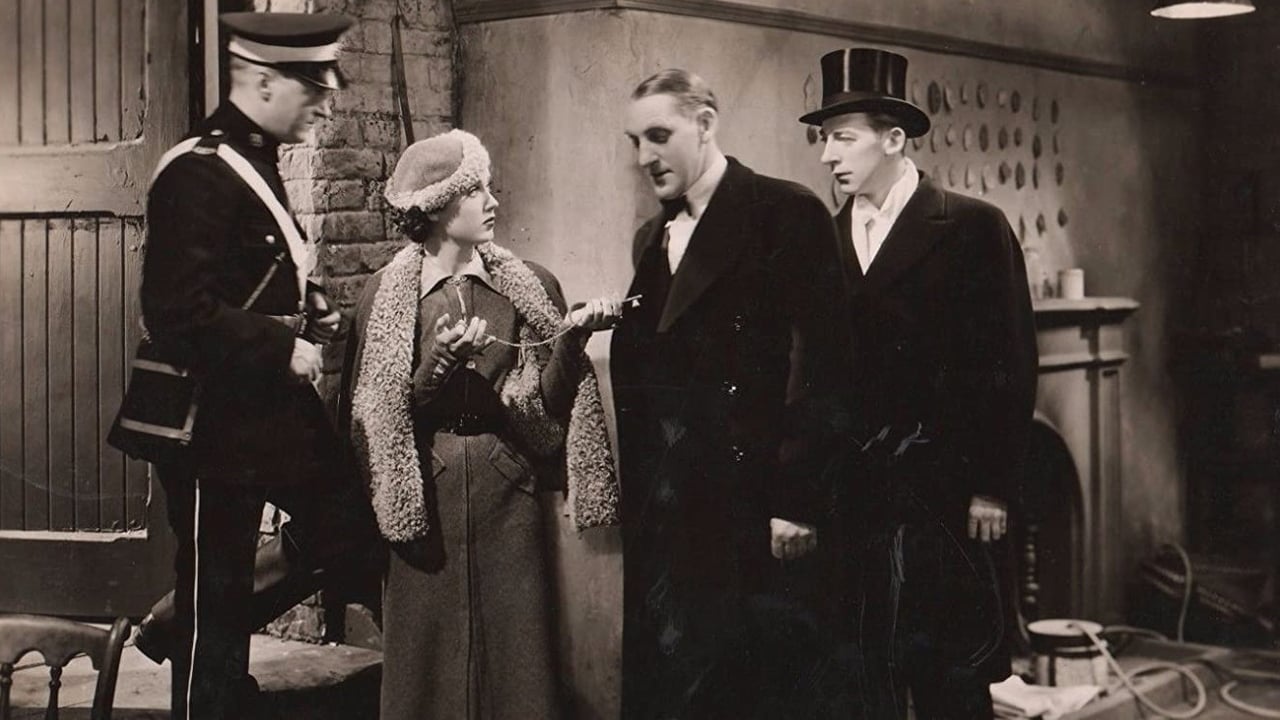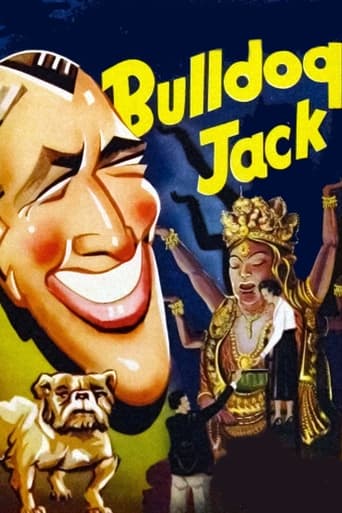

The same year that BULLDOG DRUMMOND STRIKES BACK (1934) emerged from Hollywood, Britain supplied its own adventure for the character (incarnated by Ralph Richardson) created by H.C. "Sapper" McNeile, namely THE RETURN OF BULLDOG DRUMMOND – in which he was pitted, as in the 1929 BULLDOG DRUMMOND, against his frequent antagonist Carl Peterson. A year later, a spoof (note my review of STRIKES BACK, which was itself something of a lampoon!) was produced – also in Britain – and, interestingly, Richardson here changed sides and essayed the chief villain role! Anyway, the narrative – on which the author was himself involved! – begins with the real Drummond, played by one Atholl Fleming, being put out of action after he has promised leading lady Fay Wray (in a brief U.K. stint) his help; partly to blame for this indisposition, star Jack Hulbert – pining for the thrills that are Drummond's bread-and-butter – requests to offer his services but, when he comes face to face with Wray, decides to take the case (since he had been asked by the sleuth himself to temporarily impersonate him!). Also on hand is Drummond's sidekick Algy (played by Hulbert's younger brother Claude!), who is against their getting involved further but, when the heroine is kidnapped, he joins "Bulldog Jack" (incidentally, the film was bafflingly retitled ALIAS BULLDOG DRUMMOND for the U.S.!) in pursuit.As it turns out, this is guilty of the same criticism with respect to plot that I leveled at the Ronald Colman vehicles which preceded its viewing: Wray is in the care of a grandfather, whose forgery skills are sought by Richardson in order to replace the jewels adorning the statue of an Indian goddess inside the British Museum. While Jack Hulbert does not make for the most sympathetic lead (he had earlier starred in another highly-regarded, but unfortunately only partially available, comedy-thriller by the same director: the 1931 version of THE GHOST TRAIN, whose remake – also by Forde! – made 10 years later I own and have reviewed), the film maintains a good balance between delivering laughs and creating suspense. Also notable here are the settings – as mentioned, the climax occurs in the British Museum (to where the criminals gain access through the lid of an ancient tomb!), while Richardson's hide-out is in a disused branch of the London Underground (he even escapes by assuming control of a train, but is naturally routed by the intrepid hero) – and the editing (including judicious use of overlapping dialogue and cross-cutting).To get back to THE RETURN OF BULLDOG DRUMMOND for a minute, I chose not to watch it at this juncture because I have a few more of the character's adventures (from his Hollywood run of B-movies) to go through – and, in any case, the three I did check out had earned a spot on the "Wonders In The Dark" poll of the all-time top 3000 films (even if I do not agree with its ranking this the highest)
... View MoreJack Hulbert plays a polo player named Jack Pennington who literally runs into Bulldog Drummond when Drummond's car is sabotaged to stop Drummond from helping the young woman (Fay Wray) back in London. Drummond's arm is broken in the crash and he asks Hulbert to take his place in order to get the information that will let him help the fair damsel.Hulbert of course refuses to give up the ruse and soon with the aid of Algy he's trying to rescue the kidnapped girl and best the villainous Morelle (Ralph Richardson).Moving like the wind this is a damn fine little comedy mystery. Hulbert is absolutely hysterical as the Drummond wannabe as he blusters his way in and out of danger. His insanity is absolutely charming.(He would repeat the same sort of nonsense to much the same effect three or so years later in Kate Plus Ten an adaptation of an Edgar Wallace story thats gotten better with each viewing. Fay Wray has never looked more stunning. I'm so used to her in American films which seem now never managed to show her beauty the way that this film does. As Morelle Ralph Richardson is a truly demented evil genius. Its clear he's dangerous, however he's so genuinely smooth that you almost by that he could be a nice guy.The action is first rate with the climatic underground train sequence rightly held out as a key reason to see the film. One can easily imagine that the final twists and turns had audience members seeing this on a big screen shrieking.This is a really good film and one wonders why its not currently out on DVD or, apparently, available for TV broadcast in the United States, since its easily one of the better mysteries of this sort.Yes you really do want to check this film out.(I don't know if I'd consider it a Bulldog Drummond film, partly because its so humorous, partly because Drummond isn't really in it and partly because its kind of atypical for the films that are real Drummond films. It is but its not. CAn we call it a semi-Drummond film?)
... View MoreThis film, released in the USA as 'Alias Bulldog Drummond', was the seventh Bulldog Drummond film. It was made a few months after 'The Return of Bulldog Drummond', the highly political Mosleyite Drummond film in which Ralph Richardson played Drummond for the only time. In this film, Richardson plays the villain, Morel (or Morelle). Drummond himself is briefly played in this film by Atholl Fleming, who was not very well known and only appeared in eleven films in his entire career. Drummond is injured and confined to hospital near the beginning of this film and asks another man to take his place at a meeting with a mysterious woman and report back to him, and authorises him to impersonate him and pretend to be Drummond himself. This bizarre idea was cooked up by actor Jack Hulbert, who wrote the story, as a vehicle for himself. Hulbert was a popular comedian and tap dancer in British films of the 1930s and as unlikely a man to be in a Bulldog Drummond film as can be imagined, or could be imagined then, for that matter. Hulbert was a strange-looking man with a hatchet face and an enormous pointed chin, rather like Mr. Punch. Despite these unfortunate looks, he dressed, behaved and acted like an irresistible Romeo in many films, including this one. Hulbert cast his younger brother Claude Hulbert in this film as Drummond's sidekick Algy Longworth, and that was very successful, as Claude Hulbert had no difficulty at all in acting like a twit. (Whether he was one I wouldn't know, but many were in those days.) All these men with slicked-down hair and top hats and effete manners grate on the nerves today, but it was ever so fashionable in the 1930s. Fay Wray plays the girl in distress in this film, an undemanding part which she had no trouble in mastering. The butler Tenny is played very boringly by Gibb McLaughlin in this film, where he is called 'Denny', which was a mistake, as all Drumondonians will know. The film was directed very adequately by Walter Forde. It is treated very much as a comedy thriller, with jolly music of a humorous intent laid on too thick, and people colliding on stairs, and that sort of thing. It must not be taken seriously as a Bulldog Drummond thriller, as that was not the intention at all. The chief interest of this film historically is that a lot of it was shot in the recently decommissioned (25 September 1933) Central Line underground station known variously as 'Museum' or 'British Museum', depending on the time one refers to. In the film, the stations' names are changed, so that Holborn becomes 'High Holborn' (the name of the road above), and Museum becomes 'Bloomsbury' (the area in which it lies). Museum Station lay and still lies between Tottenham Court Road Station and Holborn Station, and I have recently suggested to Mayor Boris Johnson its reopening in order to relieve the desperate overcrowding at Holborn Station, which has become intolerable and a danger to the public owing to the intensity of office development in that area and the thousands of extra people who use the station every day. This film made free use of the abandoned Museum Station, and one sees a great deal of it as it was two years after closing, when it was still in what is called in Britain 'pretty good nick', meaning 'pretty great shape' in American dialect. In the story, this abandoned station is linked to the nearby British Museum by a tunnel, through which villains gain access to priceless ancient treasures. The yarn is good, the film is not bad, one can have fun and stare incredulously at Jack Hulbert's chin, and imagine the 'lost underground station' being restored to its former glory.
... View More** small spoiler **Bulldog's car is sabotaged and he crashes into another car on his way to a mysterious mission. As it turns out, the driver of the other car is a great fan of Bulldog's work and his lifestyle. So, while Bulldog is mending in the hospital, the fan agrees to take on Bulldog's work for him. Thus begins an exercise in comedic silliness that only the Brits can do.It's not hysterically funny. It just has that sort of laid back, gentle, situation type humor that the Brits do better than anyone else.There is also enough tension and mystery to make all the running about worth while.I gave it the nine it deserved.
... View More